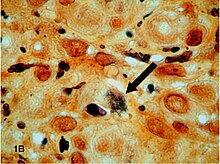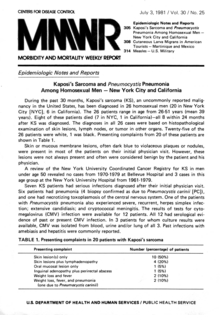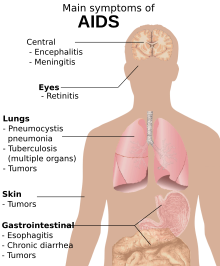User:Maaiagrant/sandbox
Comments from Heather;
[edit]9/25- Wow, Maia- you found a lot of sources. That's great! Now you need to narrow down what you want to focus on changing. ALL of this would be way too much to do. See if the Talk page helps at all...what are other people working on. This Sandbox also needs a work log with all the hours you spend working on the project and ideally a copy of the parts of the page you'll be working on. Let me know if you have questions!
10/4- Maia, please add a "work log" heading and list dates and what you worked on and for how long, okay? Next I suggest you copy and paste the part of your article you want to improve into this Sandbox. (You can just create a new heading for it below, the way Amanda does in her Sandbox.) Then you can have me and other professionals look at it before you move it to the Wikipedia main space.
10/16- Hi Maia! The "History of AIDS" section that you pasted into your Sandbox doesn't have any citations. Are you planning to add them? If so, please do and note it in your log. Thanks!
10/25- RE: your question about Sandbox. Ideally, you should edit in your Sandbox and get feedback (make sure everything looks right and nothing is plagiarized), BUT if you've already made your changes in the actual article, just please note it in your Work Log for next week so I can give you credit. :) Also, if other Wiki users give feedback on your changes, please respond to them.
Maia's Work Log
[edit]- Sep 29th - I went through the links and update 6, 71, 82, 83, 84, and 89 which were old links. Although I tried to find the original links I could not so I just set them as dead links. I added more information about the History of AIDS/HIV because I think that it needs more into depth information on the history of AIDS/HIV. (2 hours)
- Sep 30th- I decide to focus on the History of HIV/AIDS by adding more information and started to go over what I wrote to make sure it flows thoroughly. I also decide to search for more articles about the topic of history of HIV/AIDS. (2 hours)
- Oct 14th- Found parts that weren't cited therefore I decide to search for the articles and input them into the article, particularly the section History of HIV/AIDS. ( 2 hours)
- Oct 21st- I accidentally put all my work in the real article and forgot to put it into my sandbox therefore I moved it into my sand box. I also looked for more photos to put into the article and found a couple. However, I am still a bit confused on the format of the sandbox. Does the sandbox have to be exactly like the article or can we post what we did into the sandbox not in order. (1 hour and 30 mins)
- Oct 28th- I double checked all the links to make sure they worked and moved over my stuff onto the main space. (1 hour)
References used
[edit]History
“HIV and AIDS History.” CANFAR, 2018, canfar.com/hiv-and-aids/history-of-hiv/.
“A Timeline of HIV and AIDS.” HIV.gov, 10 Sept. 2018, www.hiv.gov/hiv-basics/overview/history/hiv-and-aids-timeline.
Writers, Staff. “HIV and AIDS: An Origin Story.” PublicHealth.org, PublicHealth.org, 2018, www.publichealth.org/public-awareness/hiv-aids/origin-story/.
Wilson, Jacque. “Timeline: AIDS Moments to Remember.” CNN, Cable News Network, 13 Apr. 2016, www.cnn.com/2013/03/04/health/timeline-hiv-aids-moments/index.html.
Cichocki, Mark. “The History of HIV/AIDS.” Verywell Health, Verywellhealth, www.verywellhealth.com/the-history-of-hiv-49350.
What is
Writers, Staff. “HIV/AIDS.” PublicHealth.org, PublicHealth.org, 2018, www.publichealth.org/public-awareness/hiv-aids/.
“What Are HIV and AIDS?” AVERT, Avert, 13 Aug. 2018, www.avert.org/about-hiv-aids/what-hiv-aids.
“HIV/AIDS.” Centers for Disease Control and Prevention, Centers for Disease Control and Prevention, 23 July 2018, www.cdc.gov/hiv/basics/whatishiv.html.
Treatment
“HIV/AIDS.” Mayo Clinic, Mayo Foundation for Medical Education and Research, 19 Jan. 2018, www.mayoclinic.org/diseases-conditions/hiv-aids/diagnosis-treatment/drc-20373531.
“AIDSTreatment.” UCSF Medical Center, 2018, www.ucsfhealth.org/conditions/aids/treatment.html.
“HIVTreatment.” UCSF Medical Center, 2018, www.ucsfhealth.org/conditions/hiv/treatment.html.
What I want to Improve
[edit]The relationship between HIV and AIDS
[edit]HIV is an acronym for human immunodeficiency virus, which is the virus that causes AIDS (acquired immunodeficiency syndrome). Contracting HIV can lead to the development of AIDS or stage 3 HIV, which causes serious damage to the immune system. While this virus is the underlying cause of AIDS, not all HIV-positive individuals have AIDS, as HIV can remain in a latent state for many years. Although usually AIDS is the late stage of an HIV infection. If undiagnosed or left untreated, HIV usually progresses to AIDS, defined as possessing a CD4+ lymphocyte count under 200 cells/μl or HIV infection plus co-infection with an AIDS-defining opportunistic infection. Even if treated HIV cannot be cured, but it can be treated and its transmission can be halted. By treating HIV it can prevent new infections, which is the key to ultimately defeating AIDS.
History of HIV/AIDS
[edit]Main article: Origin of AIDS
The current consensus is that HIV was introduced to North America by a Haitian immigrant who contracted it while working in the Democratic Republic of the Congo in the early 1960s, or from another person who worked there during that time.[1] In 1981 on June 5, the U.S. Centers for Disease Control and Prevention(CDC) publish a Morbidity and Mortality Weekly Report (MMWR), describing cases of a rare lung infection, Pneumocystis carinii pneumonia (PCP), from five healthy, gay men in Los Angeles. This edition would later become MMWR's first official reporting of the AIDS epidemic in North America.[2] By year-end, an cumulative total of 270 reported cases of severe immune deficiency was founded amid gay men, 121 out of the 270 reported cases had died.[2] On September 24 in 1982, CDC started to use the term “AIDS” (acquired immune deficiency syndrome) for the first time, and released the first case definition of AIDS: “a disease at least moderately predictive of a defect in cell-mediated immunity, occurring in a person with no known case for diminished resistance to that disease.”[2] Than an edition in March 4,1983 of the Morbidity and Mortality Weekly Report (MMWR), notes that CDC founded most cases of AIDS have been reported among homosexual men with multiple sexual partners, injection drug users, Haitians, and hemophiliacs. The report suggests that AIDS may be caused by an infectious agent that is transmitted sexually or through exposure to blood or blood products and issues recommendations for preventing transmission.[2] Although most cases founded of HIV/AIDS were founded in gay men on January 7, 1983 CDC reported cases of AIDS in female sexual partners of males with AIDS.[2] In 1984 Scientists identified the virus that causes AIDS, which was first named after the T-cells affected by the strain and is now called HIV or human immunodeficiency virus.[3] Afterwards, A Canadian flight attendant, dubbed "Patient Zero," dies of AIDS-related complications. His sexual connection to several of the first victims of HIV is erroneously reported that he is responsible for introducing the virus into North America. By this time there were 8,000 confirmed cases in the U.S., resulting in an alarming 3,500 deaths.[4]
On September 17,1985 President Ronald Reagan for the first time mentions AIDS and vows in a letter to Congress to make AIDS a priority.[2] In 1987 the FDA approved AZT which is the first antiretroviral drug for treating AIDS.[3] The Ad Council partners with AMFAR and the National AIDS Network in 1989 launched a national AIDS education campaign. This was the first ad campaign in the U.S. to use the word "condom." One of the campaign's slogans were "Using it won't kill you. Not using it might."[3] Singer Paul Jabara starts the Red Ribbon Foundation in 1991, which begins distributing ribbons as a symbol of tolerance for those living with HIV/AIDS.[3] At the 11th International AIDS Conference in Vancouver, combination antiretroviral treatment is presented for the first time. These drugs are shown to be effective against HIV.[3] Media outlets in 1997 started to report that for the first time since the epidemic of AIDS/HIV began, the AIDS death rate had declined in the U.S. thanks to the success of drug therapies. Researchers from the University of Alabama at Birmingham reported a discovery in 1999 of HIV-1 in a subspecies of chimpanzee. They believed this to be the source of the virus and theorize that human hunters contracted it when exposed to infected blood.[3] Later in 2003, The FDA approves the first of a new type of anti-HIV drug called Fuzeon (also known as enfuvirtide or T-20). This drug is designed to prevent the entry of HIV into human cells. George W. Bush launches PEPFAR in 2004, the U.S. President's Emergency Plan to combat AIDS worldwide. "This historic commitment is the largest by any nation to combat a single disease internationally," according to the PEPFAR website.[3] President Obama removes a travel ban in 2009 that prevented HIV-positive people from entering the U.S. This leads to the announcement that the International AIDS Conference will be held in the U.S. for the first time in more than 20 years.[3] During 2012 UNAIDS announces that new HIV infections have dropped more than 50% in 25 low- and middle-income countries, and the number of people getting antiretroviral treatment has increased 63% in the past two years. More than 34 million people are still living with HIV, according to global estimates.[3]






 | This is a user sandbox of Maaiagrant. You can use it for testing or practicing edits. This is not the sandbox where you should draft your assigned article for a dashboard.wikiedu.org course. To find the right sandbox for your assignment, visit your Dashboard course page and follow the Sandbox Draft link for your assigned article in the My Articles section. |
- ^ "Key HIV strain 'came from Haiti'". 2007-10-30. Retrieved 2018-10-22.
- ^ a b c d e f "A Timeline of HIV and AIDS". HIV.gov. Retrieved 2018-10-22.
- ^ a b c d e f g h i CNN, Jacque Wilson,. "Timeline: AIDS moments to remember". CNN. Retrieved 2018-10-22.
{{cite news}}:|last=has generic name (help)CS1 maint: extra punctuation (link) CS1 maint: multiple names: authors list (link) - ^ "The History of HIV/AIDS". Verywell Health. Retrieved 2018-10-22.
